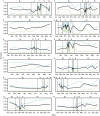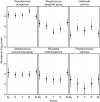Respiratory microbiota resistance and resilience to pulmonary exacerbation and subsequent antimicrobial intervention
- PMID: 26555248
- PMCID: PMC4820042
- DOI: 10.1038/ismej.2015.198
Respiratory microbiota resistance and resilience to pulmonary exacerbation and subsequent antimicrobial intervention
Abstract
Pulmonary symptoms in cystic fibrosis (CF) begin in early life with chronic lung infections and concomitant airway inflammation leading to progressive loss of lung function. Gradual pulmonary function decline is interspersed with periods of acute worsening of respiratory symptoms known as CF pulmonary exacerbations (CFPEs). Cumulatively, CFPEs are associated with more rapid disease progression. In this study multiple sputum samples were collected from adult CF patients over the course of CFPEs to better understand how changes in microbiota are associated with CFPE onset and management. Data were divided into five clinical periods: pre-CFPE baseline, CFPE, antibiotic treatment, recovery, and post-CFPE baseline. Samples were treated with propidium monoazide prior to DNA extraction, to remove the impact of bacterial cell death artefacts following antibiotic treatment, and then characterised by 16S rRNA gene-targeted high-throughput sequencing. Partitioning CF microbiota into core and rare groups revealed compositional resistance to CFPE and resilience to antibiotics interventions. Mixed effects modelling of core microbiota members revealed no significant negative impact on the relative abundance of Pseudomonas aeruginosa across the exacerbation cycle. Our findings have implications for current CFPE management strategies, supporting reassessment of existing antimicrobial treatment regimens, as antimicrobial resistance by pathogens and other members of the microbiota may be significant contributing factors.
Figures




References
-
- Brown JH, Kodric-Brown A. (1977). Turnover rates in insular biogeography: effect of immigration and extinction. Ecology 58: 445–449.
Publication types
MeSH terms
Substances
Grants and funding
LinkOut - more resources
Full Text Sources
Other Literature Sources
Medical

